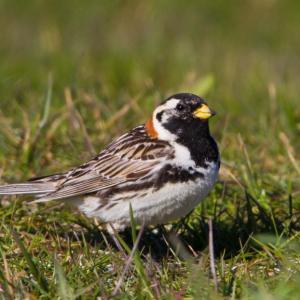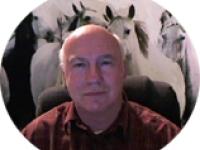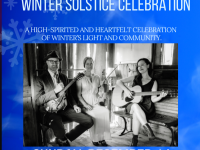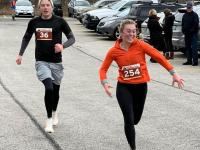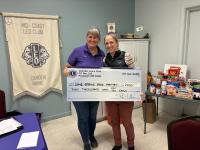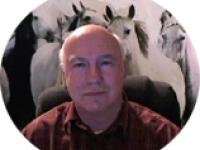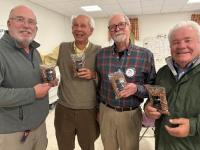Traveling Bird, Traveling Bird Exhibit
 As the authors were standing on a jetty overlooking the Gulf of Maine in Rockport, Massachusetts, they heard a mysterious but familiar call note fly in off the water - a lapland longspur (here the species is shown in breeding plumange). (Photo Wiki Commons: By Ómar Runólfsson - Flickr: Lapland Longspur - Calcarius lapponicus - Sportittlingur, CC BY 2.0, https://commons.wikimedia.org/w/index.php?curid=19955368)
As the authors were standing on a jetty overlooking the Gulf of Maine in Rockport, Massachusetts, they heard a mysterious but familiar call note fly in off the water - a lapland longspur (here the species is shown in breeding plumange). (Photo Wiki Commons: By Ómar Runólfsson - Flickr: Lapland Longspur - Calcarius lapponicus - Sportittlingur, CC BY 2.0, https://commons.wikimedia.org/w/index.php?curid=19955368) Jeff Wells, right, one of the authors of this column, standing near the traveling Smithsonian boreal exhibit at the Peabody-Essex Museum in Salem, Massachusetts. Wells was instrumental in the development of the exhibit. Courtesy photo
Jeff Wells, right, one of the authors of this column, standing near the traveling Smithsonian boreal exhibit at the Peabody-Essex Museum in Salem, Massachusetts. Wells was instrumental in the development of the exhibit. Courtesy photo The boreal birds exhibit includes interactive games for kids of all ages. All are welcome to visit the exhibit, especially in October, when the town of Salem is at its spookiest! Courtesy of Jeff Wells
The boreal birds exhibit includes interactive games for kids of all ages. All are welcome to visit the exhibit, especially in October, when the town of Salem is at its spookiest! Courtesy of Jeff Wells As the authors were standing on a jetty overlooking the Gulf of Maine in Rockport, Massachusetts, they heard a mysterious but familiar call note fly in off the water - a lapland longspur (here the species is shown in breeding plumange). (Photo Wiki Commons: By Ómar Runólfsson - Flickr: Lapland Longspur - Calcarius lapponicus - Sportittlingur, CC BY 2.0, https://commons.wikimedia.org/w/index.php?curid=19955368)
As the authors were standing on a jetty overlooking the Gulf of Maine in Rockport, Massachusetts, they heard a mysterious but familiar call note fly in off the water - a lapland longspur (here the species is shown in breeding plumange). (Photo Wiki Commons: By Ómar Runólfsson - Flickr: Lapland Longspur - Calcarius lapponicus - Sportittlingur, CC BY 2.0, https://commons.wikimedia.org/w/index.php?curid=19955368)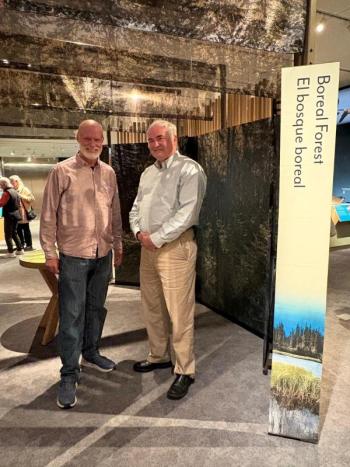 Jeff Wells, right, one of the authors of this column, standing near the traveling Smithsonian boreal exhibit at the Peabody-Essex Museum in Salem, Massachusetts. Wells was instrumental in the development of the exhibit. Courtesy photo
Jeff Wells, right, one of the authors of this column, standing near the traveling Smithsonian boreal exhibit at the Peabody-Essex Museum in Salem, Massachusetts. Wells was instrumental in the development of the exhibit. Courtesy photo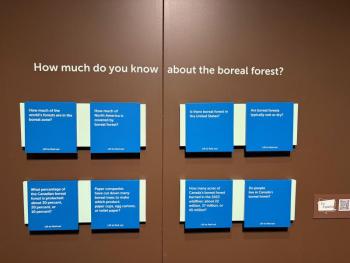 The boreal birds exhibit includes interactive games for kids of all ages. All are welcome to visit the exhibit, especially in October, when the town of Salem is at its spookiest! Courtesy of Jeff Wells
The boreal birds exhibit includes interactive games for kids of all ages. All are welcome to visit the exhibit, especially in October, when the town of Salem is at its spookiest! Courtesy of Jeff Wells
We were standing on top of a tall, hill-like jetty near Rockkport, Massachusetts, gazing out at the Gulf of Maine, when we heard a short rattling call from somewhere above us in the blue sky. It was early in the afternoon on a warm September day. The bird diversity was not overwhelming. The expected herring gulls glided by. Far out to sea on a human-made jetty of massive blocks of stone sat a preponderance of great black-backed gulls. A single northern gannet beat its long wings in the distance.
And then there was the rattle call again.
We spotted it then, a high, lone bird. It gave a gentle “tew” call and then another rattle. A snow bunting? No, the bird had no white patches in the wings. Oh, a Lapland longspur! Then the speck disappeared into the distance, heading toward land.
Both snow buntings and Lapland longspurs breed across the Arctic and come south to our area for the winter. But usually not until later in October or November. What may have driven this bird to drop south earlier? Had the bird been in Nunavut or Greenland just a few days before? Our minds turned northward.
We were in Massachusetts for events in connection with an exhibit at the Peabody-Essex Museum in Salem. The exhibit is also focused on places to our north—in this case, the Boreal Forest biome. The exhibit is called Knowing Nature: Stories of the Boreal Forest, and it will be at the museum until September 2026. It’s full of big, beautiful photos and other imagery, interactive games for kids (and kids-at-heart), and the amazing sounds of birds from the Boreal Forest softly permeate the soundscape, making it feel like a calming oasis. The exhibit is organized by season, and this version (it is a Smithsonian Traveling exhibit, making its way around the country) has a gorgeous moss wall, a historic canoe model, and an art installation by a local Indigenous artist.
The exhibit highlights many elements of the ecological as well as cultural importance of the Boreal Forest biome including sections on caribou, fish, and, of course, birds. And it highlights many Indigenous voices throughout. One corner has a short video that has wonderful interviews with Indigenous leaders as well as non-Indigenous academics and conservationists (including one of the authors here—Jeff!).
It’s well worth a visit at any time. If you are, by any chance, among the throngs of people going to Salem around Halloween time, the exhibit makes a welcome respite from the busier (and spookier) activities happening in the rest of town.
We heartily recommend a visit to Knowing Nature: Stories of the Boreal Forest at the Peabody Essex Museum in Salem, Massachusetts. https://www.pem.org/exhibitions/knowing-nature-stories-of-the-boreal-forest
Jeffrey V. Wells, Ph.D., is a Fellow of the Cornell Lab of Ornithology and Vice President of Boreal Conservation for National Audubon. Dr. Wells is one of the nation's leading bird experts and conservation biologists. He is a coauthor of the seminal “Birds of Maine” book and author of the “Birder’s Conservation Handbook.” His grandfather, the late John Chase, was a columnist for the Boothbay Register for many years. Allison Childs Wells, formerly of the Cornell Lab of Ornithology, is a senior director at the Natural Resources Council of Maine, a nonprofit membership organization working statewide to protect the nature of Maine. Both are widely published natural history writers and are the authors of the popular books, “Maine’s Favorite Birds” (Down East Books) and “Birds of Aruba, Bonaire, and Curaçao: A Site and Field Guide,” (Cornell University Press).

